We’ve been hearing a lot about bee and pollinator decline in the news. Though the implication is that “bees” means honeybees, there are over 4,000 native bee species providing us with free pollinating services — if only we provide the habitat for them to thrive.
Many native bees are oligolectic, which means they forage for pollen and nectar only on a specific species of native plant — for example, one species of goldenrod or aster. Let’s assume that a calico aster (
Symphyotrichum lateriflorum) blooms for two weeks; that’s a very small window for adults to gather pollen and bring it back to egg cells in the ground or in hollow plant stems — and those eggs will turn into larvae and overwinter eating that pollen.
What can we do in our small backyard gardens to support a diversity of bees and other pollinators? Plant as many native flowers as possible, and make sure they’re native to the area to support the largest amount of pollinators. Here are 15 native wildflowers that should be a great start in creating your own native bee garden.
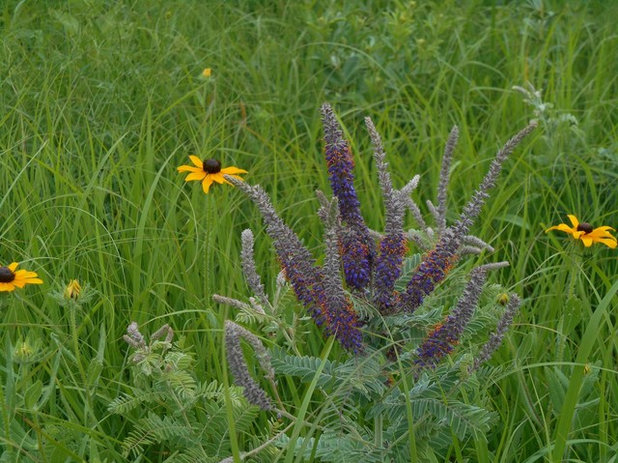
Benjamin Vogt / Monarch Gardens
Lead Plant (
Amorpha canescens)
Supports over 50 bee species and over 100 insect species
This was the plant that pioneers said made a zipping sound when they plowed up the prairie — but you can listen to the bees flocking to lead plant in early summer when you plant it. Dry soil in sun works great for this native from
Michigan to
Arkansas and west to
New Mexico, Wyoming and
South Dakota. Lead plant reaches no more than about 2 feet tall and wide and has a nice, small shrub form. In fact, you don’t even need to cut it back in spring.
See how to grow lead plant
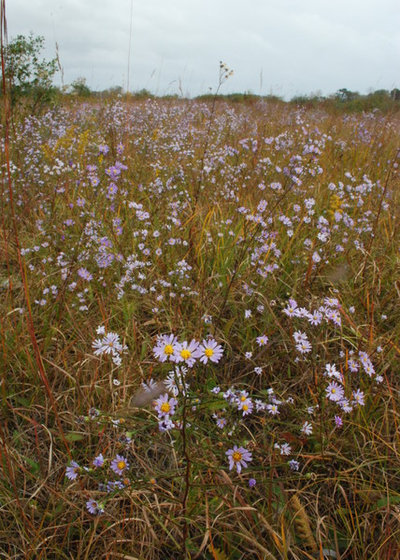 False Aster
False Aster(
Boltonia asteroides)
Supports over 40 bee species and over 100 insect species
Slightly moist to medium soil in full sun to partial shade works for false aster, which reaches 3 to 4 feet tall and wide in a large mounding shape covered in late summer to early fall with flowers. Native from
North Dakota to
Oklahoma and east to
Alabama and
Illinois, false aster is not hard to grow when you put it in the right spot.
Photo by Joshua Mayer
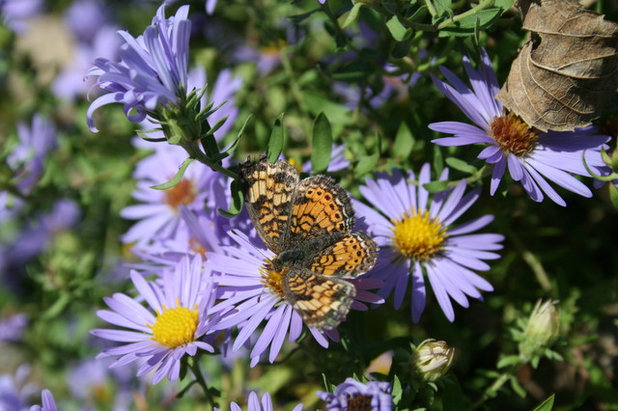
Benjamin Vogt / Monarch Gardens
Smooth Aster (
Symphyotrichum laeve)
Supports over 30 bee species and over 70 insect species
A native resident of the
Mountain West and
Central and Northern Plains, and scattered throughout the
eastern U.S., smooth aster puts on a showstopping display in midautumn. Wave your hand over it to see hundreds of insects rise into the air. It works in medium to dry soil in as much sun as you can muster, reaching 2 to 3 feet tall and wide.
See how to grow smooth aster
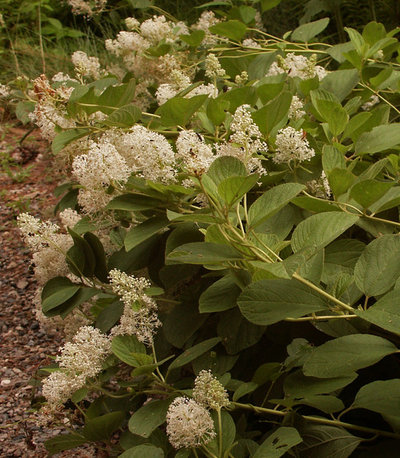
Ellen Sousa/Turkey Hill Brook Farm
New Jersey Tea (
Ceanothus americanus)
Supports over 30 bee species and over 70 insect species
Very drought tolerant, this 1- to 3-foot-tall midsummer bloomer is very hardy. Found in a wide area, it is native from
Minnesota to Texas all the way to the Atlantic, stretching into Florida and Maine. New Jersey tea is a very small shrub that should not be moved once established.
See how to grow New Jersey tea
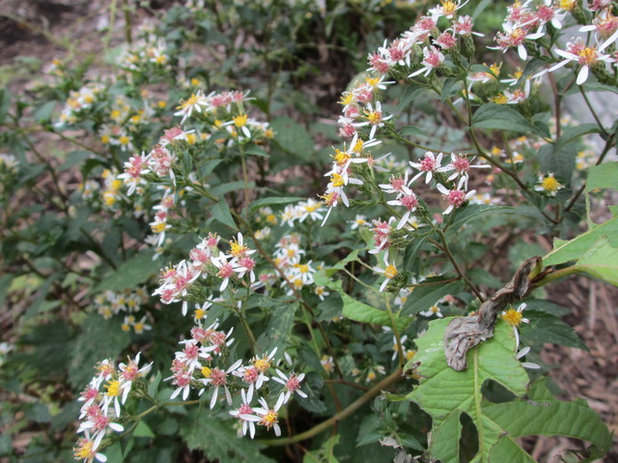
Benjamin Vogt / Monarch Gardens
Calico Aster (
Symphyotrichum lateriflorum)
Supports over 40 bee species and over 100 insect species
Got dry shade and experiencing a world of hurt trying to grow stuff in it? Try calico aster, which gets about 1 foot to 2 feet tall and wide and blooms a ton in midautumn. Native from
Minnesota to eastern Texas and all points east, this stalwart aster will create a busy buffet line.
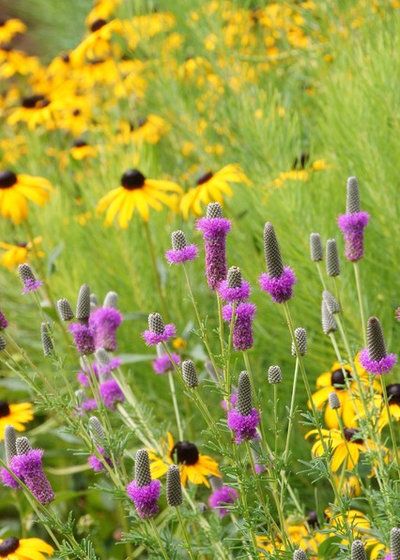
Adam Woodruff + Associates, Garden Artisans
Purple Prairie Clover (
Dalea purpurea)
Supports over 80 bee species and over 100 insect species
Perhaps the king, or queen, of bee magnetism — also a rabbit favorite, unfortunately — purple prairie clover blooms in early to mid summer, reaching 1 foot to 2 feet tall and wide. Its native range is from
Montana to New Mexico and east from Indiana to Louisiana. Give it full sun to a tad bit of shade in dry soil, and never worry about it again. Plus, it adds nitrogen to the soil.
See how to grow purple prairie clover
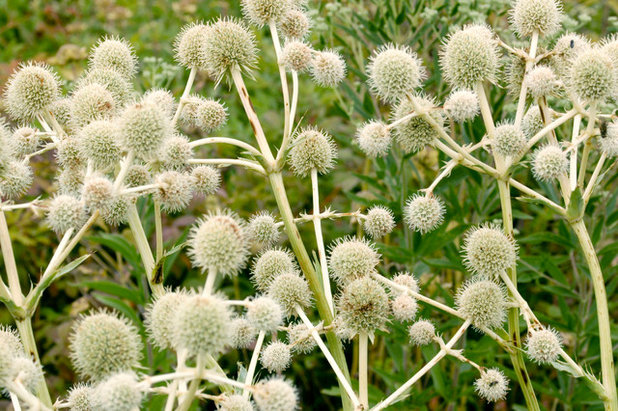
Frank Mayfield
Rattlesnake Master (
Eryngium yuccifolium)
Supports over 40 bee species and over 100 insect species
The tamer of rattlesnakes? Hardly, but a boon to pollinators. Native from
Minnesota to East Texas, then down through
Ohio and Virginia south into Florida. Slightly wet to slight dry soil is best for this fairly adaptable plant. At 4 feet tall and 2 feet wide, it has blooms in mid to late summer that are a unique standout in any garden.
See how to grow rattlesnake master
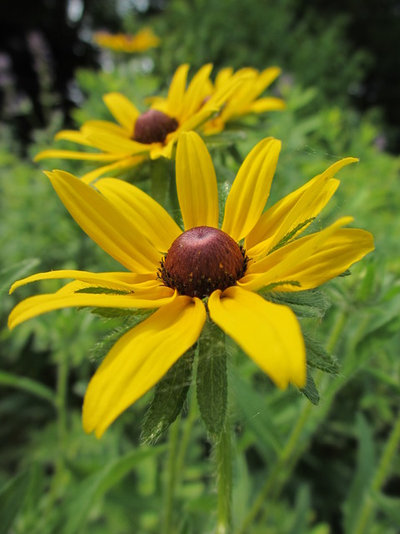
Benjamin Vogt / Monarch Gardens
Black-Eyed Susan (
Rudbeckia hirta)
Supports over 70 bee species and over 150 insect species
Who knew the humble and common black-eyed Susan was so good for wildlife? The bees did. Native pretty much everywhere
from the Rockies east, it will thrive in full to partial sun in slightly moist to dry soils. It prefers disturbed areas and tends to be the first to colonize them, eventually giving way to other perennials and grasses. Standing at 1 foot to 2 feet tall and wide, black-eyed Susan is a garden standby, blooming almost nonstop all summer long.
See how to grow black-eyed Susan
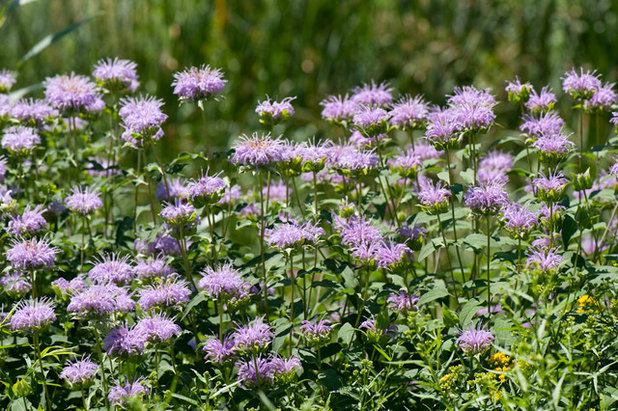
Holm Design & Consulting LLC
Wild Bergamot (
Monarda fistulosa)
Supports over 70 bee species and over 120 insect species
You’ll find this aromatic
native in all but Florida and California. Slightly moist to slightly dry soil in full sun is best for the most blooms and will minimize this plant’s tendency to lean, as it can reach 3 to 5 feet tall and spread 3 feet or so. Catch it in bloom from mid to late summer depending on its geographic range (it blooms later in the south, sooner in the north).
See how to grow wild bergamot
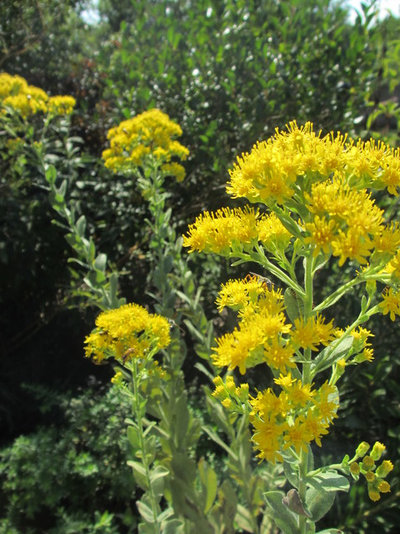
Benjamin Vogt / Monarch Gardens
Stiff Goldenrod (
Solidago rigida)
Supports over 50 bee species and over 100 insect species
Like all goldenrods, this flat-topped species supports masses of insects. Plant it in full sun with medium to dry soil.
It reaches 3 to 4 feet tall and 1 foot wide. It’s native from
New Mexico to Montana east to Indiana and Illinois, with scattered pockets in the
eastern U.S. Stiff goldenrod is an earlier-blooming Solidago, starting in August and going through September.
See how to grow stiff goldenrod
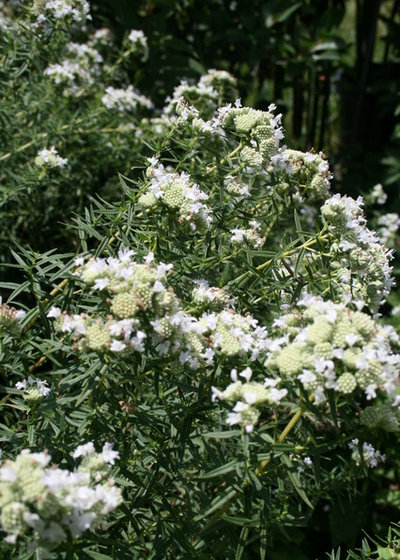
Benjamin Vogt / Monarch Gardens
Virginia Mountain Mint (
Pycnanthemum virginianum)
Supports over 50 bee species and over 100 insects species
Native to the
Central Plains, the northern and eastern
Midwest and the
Northeast, this is a most well-behaved mint.
In full sun with moist to medium soil, this stunner — which grows 2 to 3 feet tall and wide — smells lovely, remains compact and brings in the pollinators. It blooms in midsummer for weeks and weeks.
See how to grow Virginia mountain mint
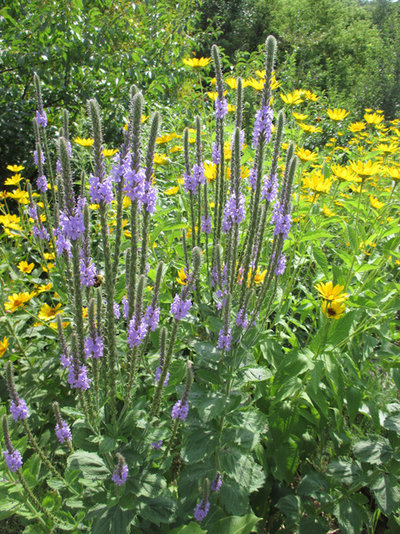
Holm Design & Consulting LLC
Hoary Vervain (
Verbena stricta)
Supports over 60 bee species and over 100 insect species
Dry, hot, baking soil? Bring it on. Hoary vervain’s native range centers on about southwest Iowa — you’ll find it at home in
Wyoming and
Colorado into
Oklahoma, then east to
Arkansas,
Ohio and
Michigan, and north into
Minnesota and the
Dakotas.
It reaches 1 foot to 2 feet tall and wide and blooms from June to August in mostly full sun. It will self-sow in open soil, but in a thick garden bed, it’ll behave if not fade away over time.
See how to grow hoary vervain
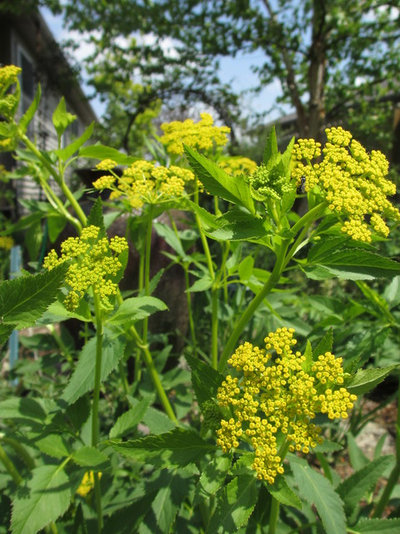
Benjamin Vogt / Monarch Gardens
Golden Alexanders (
Zizia aurea)
Supports over 70 bee species and over 130 insect species
This easygoing plant is native from the
Dakotas south to Texas and east; full sun and moist to dry soil work best for it. Growing 2 to 3 feet tall and wide, this late-spring to early-summer bloomer serves as a host plant for black swallowtail butterflies. There is nice reddish-burgundy-green fall foliage as well.
See how to grow Golden Alexanders
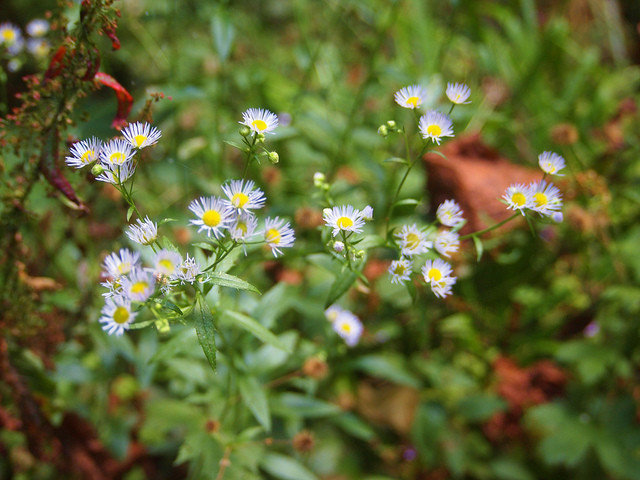 Pacific Aster
Pacific Aster
(
Symphyotrichum chilense)
Found in
California, Oregon and Washington, this aster blooms anytime from midsummer into fall. It’s fairly adaptable, growing in dry slopes to moist coastal locations and marshes. It grows 1 foot to 3 feet tall and needs a bit of room, because it spreads by rhizomes.
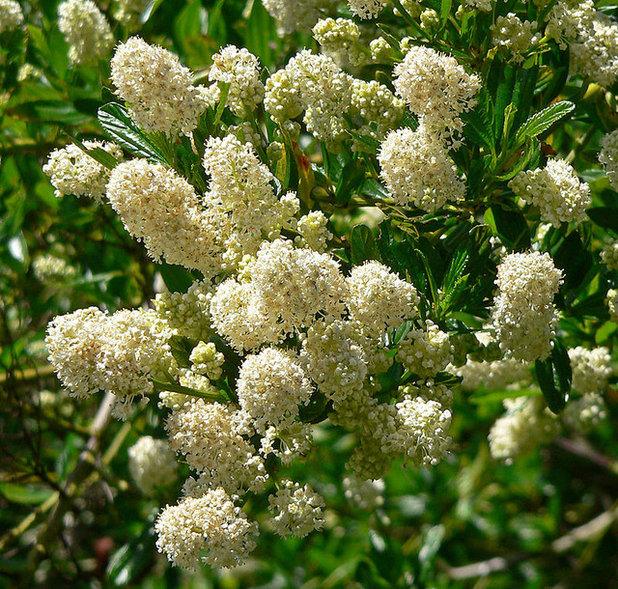 Wild Lilac
Wild Lilac(
Ceanothus thyrsiflorus)
This is the western relative of New Jersey tea, so you know it’ll bring in the pollinators. It is native from
California into Oregon and will reach anywhere from 3 to 18 feet tall — treat it more like a shrub or small tree. It puts on a glorious and fragrant spring show, which is a welcome sign to many early-season insects.
See how to grow wild lilac
To discover more about what types of pollinators you can get with a variety of native plants in the U.S. Plains and other parts of the country, head on over to Illinois Wildflowers.
More:How to Find the Right Natives Plants for Your Yard
Gardening for the Bees, and Why It’s a Good Thing
How to Design a Garden for Native Bees





